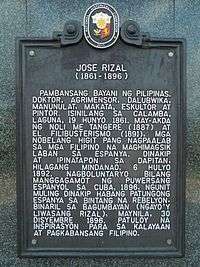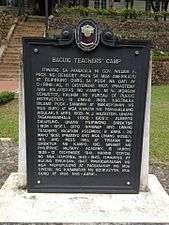Historical markers of the Philippines

Historical markers are installed by the National Historical Commission of the Philippines (NHCP) in the Philippines and places abroad that signify important events, persons,[1][2] structures,[3] and institutions in Philippine national and local histories.[4] The plaques themselves are permanent signs installed in publicly visible locations on buildings, monuments, or in special locations.
While many Cultural Properties have historical markers installed, not all places marked with historical markers are designated into one of the particular categories of Cultural Properties. As of January 2012, the total number of historical markers is 459.[5]
History

The earliest predecessor of the National Historical Commission of the Philippines (NHCP) was the Philippine Historical Research and Markers Committee. Established in 1933 during the American colonial era, one of its tasks was to mark cultural and historical antiquities in Manila, which was later expanded to cover the rest of the Philippines. The first markers were installed in 1934, including ones for Church of San Agustin, Fort Santiago, Plaza McKinley, Roman Catholic Cathedral of Manila, San Sebastian Church, Concordia College, and Manila Railroad Company. Some of these markers were either lost or destroyed during World War II and new markers were installed as replacements for San Agustin Church and Manila Cathedral. The standard shape of markers has changed throughout the years.
Historical markers by region
These lists of historical markers installed by the National Historical Commission of the Philippines (NHCP) are annotated lists of people, places, or events in the Philippines that have been commemorated by cast-iron plaques issued by the said commission.
There are markers installed by the NHCP outside the Philippines commemorating Philippine-related events, and there is a separate list on these markers.
- National Capital Region
- Cordillera Administrative Region
- Region I: Ilocos Region
- Region II: Cagayan Valley
- Region III: Central Luzon
- Region IV-A: Calabarzon
- Region IV-B: Mimaropa
- Region V: Bicol Region
- Region VI: Western Visayas
- Negros Island Region
- Region VII: Central Visayas
- Region VIII: Eastern Visayas
- Region IX: Zamboanga Peninsula
- Region X: Northern Mindanao
- Region XI: Davao Region
- Region XII: Soccsksargen
- Region XIII: Caraga
- Autonomous Region in Muslim Mindanao
- Overseas
Gallery
- Ateneo de Manila, Intramuros, Manila (currently in NHCP storage)
 Nielson Tower, Ayala, Makati City
Nielson Tower, Ayala, Makati City Pang-alaalang Bantayog (World War II heroes of Pasig memorial), Caruncho Avenue, Malinao, Pasig City
Pang-alaalang Bantayog (World War II heroes of Pasig memorial), Caruncho Avenue, Malinao, Pasig City.jpg) Leon Ma. Guerrero (1915 - 1982), Nuestra Señora de Guia Plaza, Ermita, Manila
Leon Ma. Guerrero (1915 - 1982), Nuestra Señora de Guia Plaza, Ermita, Manila Baguio Teachers' Camp, Baguio City
Baguio Teachers' Camp, Baguio City- Mansion Syquia, Vigan City, Ilocos Sur
 Church of Tumauini, Tumauini, Isabela
Church of Tumauini, Tumauini, Isabela Republika Pilipina 1898-1901, Church of the Immaculate Conception, Malolos City, Bulacan
Republika Pilipina 1898-1901, Church of the Immaculate Conception, Malolos City, Bulacan- Church of Ibaan, Ibaan, Batangas
 Fifteen Martyrs of Bicol, Naga City, Camarines Sur
Fifteen Martyrs of Bicol, Naga City, Camarines Sur- Miag-ao Church, Miag-ao, Iloilo
- Carlos P. Garcia House, Tagbilaran, Bohol
- Fort Pilar, Zamboanga City
- Immaculate Concepcion Church of Tamontaka, Cotabato City
See also
- Lists of Cultural Properties of the Philippines
- List of National Cultural Treasures in the Philippines
References
- ↑ "Cardinal's historical marker unveiled". GMA News. 7 September 2008. Retrieved 20 June 2016.
- ↑ Orejas, Tonette (13 June 2016). "NHCP corrects error over true hero of Battle of Bangkusay". Philippine Daily Inquirer. Retrieved 20 June 2016.
- ↑ Reyes, Jonas (27 November 2013). "Historical marker in Subic unveiled". Manila Bulletin. Retrieved 20 June 2016.
- ↑ Rosales, Mellanie (3 December 2010). "UP Cebu unveils historical marker". The Freeman. Retrieved 20 June 2016.
- ↑ "LIST OF HISTORIC SITES AND STRUCTURES INSTALLED WITH HISTORICAL MARKERS" (PDF). National Historical Commission of the Philippines. 16 January 2012. Archived from the original (PDF) on 4 March 2016. Retrieved 20 June 2016.
External links
| Wikimedia Commons has media related to Historical markers in the Philippines. |
- A list of sites and structures with historical markers, as of 16 January 2012
- A list of institutions with historical markers, as of 16 January 2012
- National Registry of Historic Sites and Structures in the Philippines
- Policies on the Installation of Historical Markers